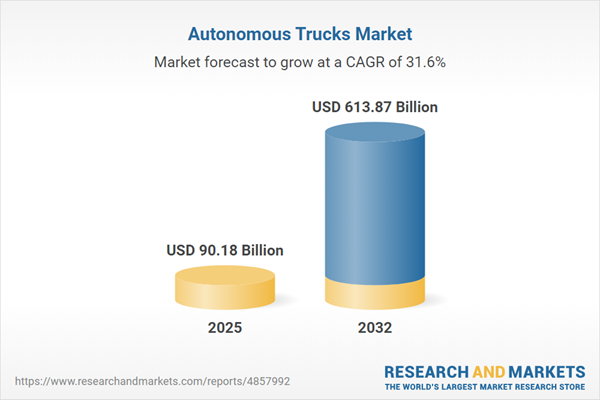Speak directly to the analyst to clarify any post sales queries you may have.
The autonomous trucks market is rapidly redefining the future of freight logistics by merging leading-edge technology, evolving regulatory frameworks, and multi-stakeholder collaboration. As a pivotal segment within the intelligent transportation space, autonomous solutions are transforming operational performance while introducing new business models across global supply chains.
Market Snapshot: Autonomous Trucks Market Size and Growth
The Autonomous Trucks Market grew from USD 68.34 billion in 2024 to USD 90.18 billion in 2025. It is projected to expand at a compound annual growth rate (CAGR) of 31.57%, reaching USD 613.87 billion by 2032. This robust trajectory underscores the integration of advanced artificial intelligence, sensor technologies, and digital infrastructure that continue to drive rapid commercialization and stakeholder adoption. Sophisticated technology integration and investments in cybersecurity, connectivity, and electrification further support market dynamism and evolution.
Scope & Segmentation
- Level of Autonomy: Level 1, Level 2, Level 3, Level 4, Level 5
- Truck Type: Heavy-Duty, Light-Duty, Medium-Duty
- Powertrain Type: Electric, Hybrid, Internal Combustion Engine
- Application: Last-Mile (Rural Delivery, Urban Distribution), Long-Haul (Intercity, Regional), Middle-Mile (Cross-Docking, Warehouse To Retail)
- Regional Coverage: Americas (United States, Canada, Mexico, Brazil, Argentina, Chile, Colombia, Peru), Europe, Middle East & Africa (United Kingdom, Germany, France, Russia, Italy, Spain, Netherlands, Sweden, Poland, Switzerland, United Arab Emirates, Saudi Arabia, Qatar, Turkey, Israel, South Africa, Nigeria, Egypt, Kenya), Asia-Pacific (China, India, Japan, Australia, South Korea, Indonesia, Thailand, Malaysia, Singapore, Taiwan)
- Leading Companies Analyzed: TuSimple, Inc.; Plus.ai, Inc.; Waymo LLC; Aurora Innovation, Inc.; Embark Trucks, Inc.; Einride AB; Kodiak Robotics, Inc.; Gatik AI, Inc.; Daimler Truck AG; AB Volvo
Key Takeaways for Senior Decision-Makers
- Industry momentum is fueled by collaborative efforts between regulators, technology providers, and OEMs, driving deployment readiness and aligning standards for safety, liability, and cybersecurity.
- Autonomous solutions are addressing labor shortages and congestion, offering scalable alternatives to traditional freight, and reinforcing supply chain resilience by reducing dependency on manual driving.
- Technological advancements in machine learning, sensor fusion, V2X communication, and real-time connectivity are supporting tailored platforms for distinct logistics scenarios—from urban last-mile to cross-continental long-haul operations.
- Strategic partnerships, joint ventures, and licensing agreements are establishing an agile ecosystem that prioritizes interoperability, accelerates time to market, and supports rapid scaling without compromising safety standards.
- Sustainability imperatives, including electrification and advanced powertrain development, position autonomous trucks at the intersection of decarbonization and digital transformation, aligning with broader ESG goals.
- Region-specific investments in digital infrastructure and scenario testing are paving the way for localized deployment and incremental regulatory harmonization across key trading corridors.
Tariff Impact on Autonomous Truck Supply Chains
Revisions to United States tariff policies in 2025 have amplified the complexity of sourcing critical components such as LiDAR, high-performance processors, and semiconductor chips. These adjustments have altered procurement dynamics, prompting manufacturers to prioritize localization, nearshoring, and long-term supplier diversification. Companies are strategically managing these pressures by enhancing supply chain agility, reinforcing collaboration between hardware specialists and software innovators, and advancing domestic manufacturing initiatives.
Methodology & Data Sources
This research is grounded in a structured, multi-phase approach, blending comprehensive secondary analysis of industry publications and regulatory standards with primary interviews involving manufacturers, technology partners, and logistics providers. Data triangulation, scenario planning, and sensitivity analysis underpin the findings, ensuring reliable, actionable insights for executive decision-makers.
Why This Report Matters
- Gain a competitive edge by understanding actionable strategies for technology adoption, regulatory compliance, and ecosystem collaboration within the autonomous trucks market.
- Identify key growth opportunities and risk factors to inform capital allocation, supply chain design, and product innovation strategies aligned to your organization’s goals.
- Leverage clarity on segment and regional trends to support informed, forward-looking business decisions that adapt to the pace of digital transformation.
Conclusion
The autonomous trucks market is rapidly transitioning from pilot programs to commercial reality, with innovation, collaboration, and agile strategies defining success. Stakeholders who capitalize on emerging opportunities will be well-positioned to shape the next era of freight transportation.
Additional Product Information:
- Purchase of this report includes 1 year online access with quarterly updates.
- This report can be updated on request. Please contact our Customer Experience team using the Ask a Question widget on our website.
Table of Contents
3. Executive Summary
4. Market Overview
7. Cumulative Impact of Artificial Intelligence 2025
Companies Mentioned
The companies profiled in this Autonomous Trucks market report include:- TuSimple, Inc.
- Plus.ai, Inc.
- Waymo LLC
- Aurora Innovation, Inc.
- Embark Trucks, Inc.
- Einride AB
- Kodiak Robotics, Inc.
- Gatik AI, Inc.
- Daimler Truck AG
- AB Volvo
Table Information
| Report Attribute | Details |
|---|---|
| No. of Pages | 195 |
| Published | October 2025 |
| Forecast Period | 2025 - 2032 |
| Estimated Market Value ( USD | $ 90.18 Billion |
| Forecasted Market Value ( USD | $ 613.87 Billion |
| Compound Annual Growth Rate | 31.5% |
| Regions Covered | Global |
| No. of Companies Mentioned | 11 |









